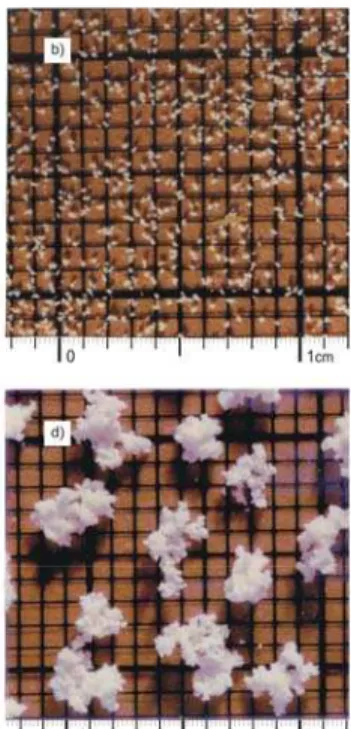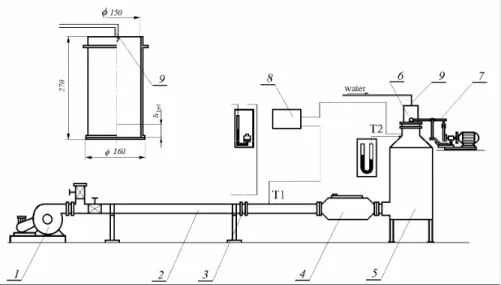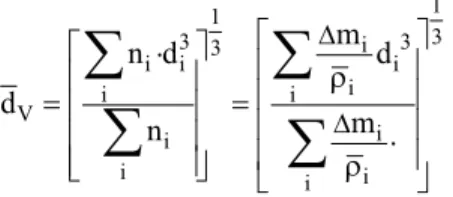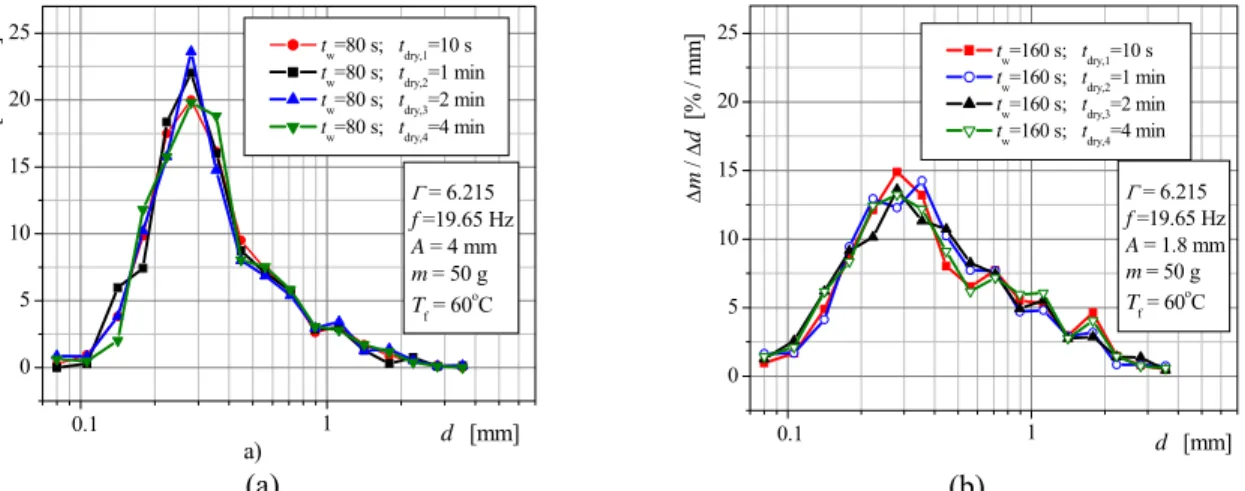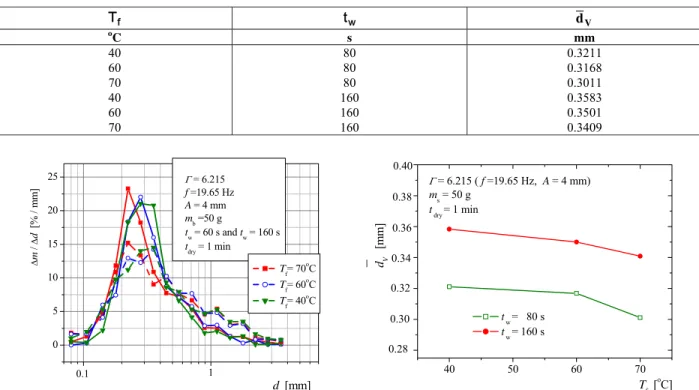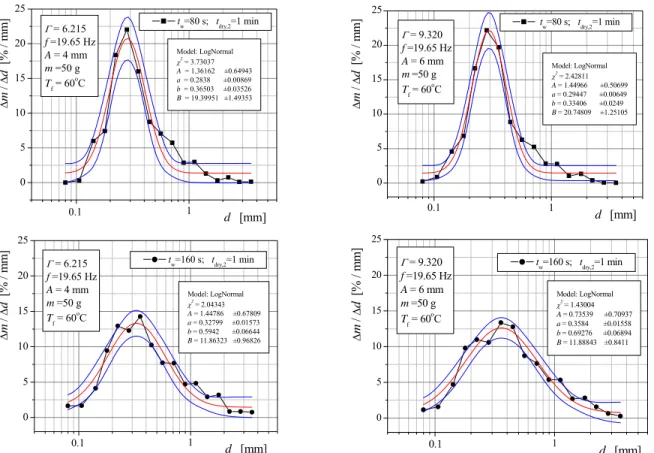ISSN 0104-6632 Printed in Brazil
www.abeq.org.br/bjche
Vol. 26, No. 03, pp. 515 - 525, July - September, 2009
Brazilian Journal
of Chemical
Engineering
SIZE DISTRIBUTION OF AGGLOMERATES OF
MILK POWDER IN WET GRANULATION
PROCESS IN A VIBRO-FLUIDIZED BED
M. Banjac
1*, M. Stameni
ć
2, M. Le
č
i
ć
3and M. Staki
ć
41
Faculty of Mechanical Engineering, University of Belgrade, Phone: +381 11 3370 318, Fax: +381 11 3370 364, Kraljice Marije 16, 11120 Belgrade, Serbia.
E-mail: mbanjac@mas.bg.ac.rs 2
Faculty of Mechanical Engineering, University of Belgrade, Phone: +381 11 3370 366, Fax: +381 11 3370 364, Kraljice Marije 16, 11120 Belgrade, Serbia.
E-mail: mstamenic@mas.bg.ac.rs 3
Faculty of Mechanical Engineering, University of Belgrade, Phone: +381 11 3302 307, Fax: +381 11 3370 364, Kraljice Marije 16, 11120 Belgrade, Serbia.
E-mail: mlecic@mas.bg.ac.rs 4
Institute for Nuclear Sciences "Vinča", PO Box 522 11001 Belgrade, Phone: +381 11 8066 424, ext. 310 Serbia.
E-mail: mstakic@vin.bg.ac.rs
(Submitted: April 24, 2008 ; Revised: December 9, 2008 ; Accepted: December 19, 2008)
Abstract - Results of experiments on the influence of technological parameters (intensity of vibration, granulation of the liquid feed, temperature of fluidization agent) on the change of size distribution, as well as mass mean diameter of the milk powder particles subjected to the wet granulation process (agglomeration) in a vibro-fluidized bed granulator are shown in this paper. Using water as a granulation liquid and air as a fluidization agent, it was found that mass mean diameter increases with increase of water feed, intensity of vibration, and decrease of air temperature. Increasing the intensity of vibration and decreasing the air temperature, primarily induces the increase of the dimensions of the initial nuclei. This can be explained on the basis of different influences that these changes (velocity of particle motion, intensity of particle collision, drying rate) have on the coalescence of particles with smaller and/or bigger dimensions.
Keywords:Drying; Vibro-fluidized bed; Agglomerates size distribution.
INTRODUCTION
Among many different techniques, the wet granulation process in a fluidized bed is the most interesting one. It originated from the tendency to perform all the necessary technological requirements for the process within one device (in the case of wet granulation: mixing and moisturizing the particles, evaporation of water, and drying the produced granules). The main purpose of mechanical vibrations in a vibro-fluidized bed is to overcome the problems
usage of vibro-fluidized bed enables easier control of residence time by manipulating vibration parameters without affecting the gas flow rates, reduced gas requirements, higher heat and mass transfer coefficients, etc.
Granule formation and growth during the wet granulation process begins with spraying the granulation liquid (solution, suspension, or pure water) upon the surface of the solid particles. The size of the liquid droplets is usually smaller than the size of solid particles. An atomizer (nozzle) is usually placed above or inside the bed of particles. When the granulation liquid contacts the surface of the particle, a liquid film is formed in one part or on the total particle surface. Depending on numerous technological parameters, the kind of granulation liquid as well as properties and dimensions of the initial material, granules will be formed by the agglomeration mechanism or by the layering mechanism, i.e., by the combination of both.
Although, the list of the papers dealing with the influence of certain technological parameters on the properties and/or quality of the granules formed by layering in a fluidized bed is quite long, the number of those dealing with granules formed by agglomeration in the same bed is smaller and the number of analyses on agglomeration process of particles in a vibro-fluidized bed is even smaller (Cruz et al., 2005;
Birchal and Passos, 2005; Erdesz and Ormos, 1986; Erdesz, 1984). The aim of this paper is to make one more step in the explanation of the influence of the energetic action of vibrations, temperature of vibro-fluidized bed, and granulation liquid feed on the kinetics of growth as well as size distribution of milk granules obtained in a wet granulation process in a vibro-fluidized bed. Analysis in this paper was performed on the basis of our own experimental results.
Milk powder granulation (agglomeration) is a process of transforming the material from the state of powder to the state of granules with porous-grained structure (Figure 1). The purpose of this process is to enable better reconstitution of milk, and to improve the rate of reconstitution (the rate of dissolving milk in water), trying to avoid the disturbance of other milk properties while doing this. The increase of the reconstitution rate is enabled by producing the appropriate porous-grained structure as well as the size of the granules. The granules’ porous structure enables intensification of water sorption by action of capillary forces, while size magnification decreases the action of van der Waals forces, increasing the sinking velocity, thus avoiding high concentration film formation around the particle, which disables further dissolving process (Sherrington and Oliver, 1981).
Figure 1: Phase of growing granules - porous-grained structure of milk a) “raw” milk powder; b) initiate
Figure 2: Experimental installation
MATERIAL AND METHODS
Experimental Installation
Experimental batch granulation device (Figure 2), consisting of radial fan (1), long horizontal pipe (2) with one flow-measuring orifice plate (3) and electrical heater (4), an air chamber (5) used to produce uniform air distribution through the bed of particles, granulation vessel (6) with internal diameter of 150 mm, and vibration device (7), was equipped with all necessary measuring and regulation equipment connected to the Hewlett-Packard HP38528 data acquisition system and HP1000 computer system (8), thus making sampling and processing of experimental data fully automated. Air temperature after the orifice plate (T1) and before the distributor plate (T2) are measured by means of pre-calibrated thermocouples (K-type, accuracy of
0.2 C
± ° ). Water was sprayed into the vessel through
the nozzle (9) placed 270 mm above the distributor plate. Two frequencies (9.65 Hz and 19.65 Hz) and amplitude range 0-6 mm of vertical vibrations were possible to obtain using the vibration device. Experiments were carried out using milk powder with initial moisture content of 3.5-4% (wet basis), while water was used as the granulation liquid.
Material Used
Experiments were carried out using milk powder produced by DD "Mlekara Subotica", with initial moisture content of 3.5-4 % (wet basis). Size
distribution (mass fractions) for mentioned “raw” milk powder was determined using sedimentation method in a Sharples-Micromerograph device.
Granulation Procedure
Process of milk powder granulation was carried out through the following technological phases:
Material charge - placement of a weighed “raw”
milk powder (0.050 kg) in the granulation vessel, thus obtaining a fixed bed of approximately 7 mm height,
Bed transformation - transformation of the fixed bed into a vibro-fluidized bed,
Wetting phase - moisturizing periodically (each
10 seconds) the surfaces of the moving dry particles by spraying water through the nozzle above the bed (0.38 grams of water for each time interval),
Drying phase - drying of produced sample in a
vibro-fluidized bed, which begins just after the wetting phase,
Bed transformation - transformation of the vibro-fluidized bed in to the fixed one by switching the vibration mechanism off,
Additional drying phase - drying the sample in a fixed bed up to the final moisture of 3-4% (wet basis).
the additional drying phase, the conditions for carrying out the sieve analysis were obtained. This analysis was performed for all the samples on vibrated sieves within the limited time interval of 15 minutes.
A number of experimental series were carried out in order to find the influence of a single technological parameter (mass of binding feed (mw),
intensity of vibration (Γ ), and the temperature of fluidization air Tf) on the particle size distribution
during the granulation process. Experimental series differed only in the values of a single technological parameter. Each experiment was repeated three times to obtain representative mean values of the measured parameters. Initial sample mass (0.05 kg), air velocity (0.31 m/s), water temperature (18°C), and period of water feeding (each 10 seconds 0.38 grams of water was sprayed into the granulation vessel) had the same value in all performed experiments. During single experiment, air temperature and intensity of vibration were kept constant. Because only a certain amount of sprayed water feed was able to reach the bed of particles, average moisture of the bed was determined in a separate set of experiments, which are performed under the same conditions as for the experiments to obtain the samples for particle size distribution analysis. Temperature and humidity of the surrounding air were also measured during the experiments and during sieve analysis, but these parameters were considered to be of limited influence.
RESULTS
Results of sieve analysis of corresponding samples are presented in two different ways. One is distribution of particle relative mass fraction as a function of diameter, while the other is change of
particle mass mean diameter dV, calculated
according to following expression:
1 1
3
3 3 i 3
i i i
i
i i
V
i i
i i i
m
n d d
d
m n
Δ
Δ
⎡ ⎤
⎡ ⋅ ⎤ ⎢ ⎥
ρ
⎢ ⎥ ⎢ ⎥
=⎢ ⎥ =
⎢ ⎥
⎢ ⎥ ⎢ ⋅ ⎥
⎢ ⎥ ρ
⎣ ⎦ ⎣ ⎦
∑
∑
∑
∑
(1)where: n - number of particles (granules) of ii th size
interval, Δmi- mass of particles (granules) of ith size interval, ρi- average density of particles of ith size interval, and di - particle geometric mean diameter of
ith size interval equal to (d1·d2)1/2, where d1 and d2
represent the size of the openings of two sieves holding the particles of ith size interval. Mass mean diameter is commonly used in order to describe the data obtained by granulation process according to the main purpose of granulation, which is enlargement of particle mass (Bin et al., 1985). Particle (granule) density having non-porous structure, (di < 0.22 mm),
was determined as ρi = 1.03 (kg/m3) by using an
AccuPyc 1330 Pycnometer (standard method).
Non-porous structure of these granules (di < 0.22 mm) is determined by visual checking (e.g.
Figure 1b) and the fact that their density is almost the same as the density of “raw” milk powder.
In the case of larger granules having porous structure, density was obtained by measuring the mass of a certain number of particles (nj>100) and
calculated according to:
j
i 3
i j 6 m
d n Δ ρ =
π (2)
where: Δmj - weighed mass of nj particles, di - particle
geometric mean diameter of ith size interval, nj -
number of particles. Change of particle density versus diameter is shown in Figure 3 for four granulated milk powder samples obtained under the different technological parameters of the granulation process:
a) Tf = 60°C, Γ = 6.215, tw = 80 s;
b) Tf = 40°C, Γ = 6.215, tw = 80 s;
c) Tf = 60°C, Γ = 2.797, tw = 80 s;
d) Tf = 60°C, Γ = 6.215, tw = 160 s.
As there was no significant change of the particle (granule) density observed as a function of applied technological parameters, it can be assumed that granule density in the case of di>0.22 mm depends
only on granule diameter. This dependence is approximated by a polynomial regression of the third order:
2 3
1.04491 0.07729 d 0.10825 d + 0.02309 d
0 1 2 3 4 0.0
0.2 0.4 0.6 0.8 1.0 1.2
_
d [mm]
ρ (d) =1.04491-0.07729 d-0.10825 d2 + +0.02309 d3
a b c d mean
ρ
[kg/m
3 ]
a) Tf = 60°C, Γ = 6.215, f = 19.65 Hz,
A = 4 mm, tw = 80 s,
b) Tf = 40°C, Γ = 6.215, f = 19.65 Hz,
A = 4 mm,tw = 80 s,
c) Tf = 60°C, Γ = 2.797, f = 19.65 Hz,
A = 1,8 mm, tw = 80 s,
d) Tf = 60°C, Γ = 6.215, f = 19.65 Hz,
A = 4 mm, tw = 160 s.
Figure 3: Particle (granule) density change
In order to obtain kinetics of granule growth the size distributions of the samples obtained during wetting phase of the milk powder granulation in a vibro-fluidized bed for four different water feeds (8mw0, 12mw0, 16mw0, and 20mw0, where mw0 = 0.38 g)
were determined. The duration of the wetting phase (tw) was 80 s, 120 s, 160 s or 200 s, respectively, with
periodical water feeding (each 10 s). The state of vibro-fluidization was kept for 10 seconds after the last water feeding; then vibrations were stopped and the obtained granules were additionally dried in a fixed bed. Results of the obtained size distribution are shown in Figure 4.
Size distributions of the samples during the drying phase were obtained for three different time intervals (1, 2 and 4 minutes) after finishing the
wetting phase, for the cases of different duration of wetting phase (80, 160 and 200 s). Samples were also additionally dried in a fixed bed. Results of the obtained size distribution are shown in Figures 5.a and 5.b. For all experiments, intensity of vibration was Γ = 6.215, while air temperature was 60°C.
Common results of the mentioned experiments are shown in Figure 6. It can be seen that granule growth occurred only during the wetting phase, while during the drying phase (10 seconds more after the wetting period) there was no change of mean diameter or size distribution, even at the maximum average moisture of the bed (9%). Diagrams of similar shape were obtained for other experiments carried under the different intensity of vibration and air temperature.
1 0
5 10 15 20 25
0.1
Γ = 2.797 f =19.65 Hz A = 1.8 mm mb = 50 g Tf = 60oC
Δ
m
/
Δ
d
[%
/
m
m
]
d [mm] tw1=80 s; tdry=1 min tw2=120 s; tdry=1 min
tw3=160 s; tdry=1 min tw4=200 s; tdry=1 min
1 0 5 10 15 20 25 0.1 a)
Γ = 6.215 f =19.65 Hz A = 4 mm m = 50 g Tf = 60oC
Δ m / Δ d [ % / m m ]
d [mm] t
w=80 s; tdry,1=10 s t
w=80 s; tdry,2=1 min t
w=80 s; tdry,3=2 min t
w=80 s; tdry,4=4 min
(a) 1 0 5 10 15 20 25 0.1
Γ = 6.215 f =19.65 Hz A = 1.8 mm m = 50 g Tf = 60oC
Δ m / Δ d [% / m m ]
d [mm] tw=160 s; tdry,1=10 s tw=160 s; tdry,2=1 min tw=160 s; tdry,3=2 min tw=160 s; tdry,4=4 min
(b)
Figure 5: Distribution of relative mass fraction for two different durations of wetting period,
a) 80 s and b) 160 s, and four durations of drying period
0 100 200 300 400 500
0.5
0.4
0.3
0.1
_
Γ = 6.215 f =19.65 Hz A = 4 mm mb = 50 g Tf = 60o
C
d V
[m
m
]
t [s]
tw1 = 80 s tw2 = 160 s t
w3 = 200 s
0 5 10 15 20 0.2 m o istu re cont en t ( w et basis ) [ % ] moisture content
Figure 6: Change of mass mean diameter as a function of different periods of wetting phase and drying phase
Experimental investigations were also carried out in order to obtain the influence of intensity of vibration on granule growth. Relative mass fraction distributions of the milk granules versus diameter obtained for two extreme cases of intensity of vibration are shown in Figure 7, while the influence of the intensity of vibration and water feed on the mass mean diameter of the milk granules can be seen in Table 1 and Figure 8. Experiments were carried out for tw = 80 s and tw = 160 s, under constant air
temperature of 60oC. It can be seen (Figure 8) that intensity of vibration has negligible influence on particle mass mean diameter, which corresponds with experimental investigations (Erdesz and Ormos, 1986), but there is a certain change of size distribution influenced by the intensity of vibration (Figure 7). Increase of intensity of vibration moves the accumulation point slightly to the right, i.e., towards the higher diameters. Observing the two phases of milk granules growth existing in a vibro-fluidized bed (Banjac et al. 1997), where initial nuclei of granules (size of 0.1-0.2 mm) are formed in
the first phase, while in the second phase are formed nuclei coalesce, and taking into account previously observed and mentioned changes, the conclusion can be derived that an increase of intensity of vibration only influences the size of initial nuclei. Influence of
air temperature (Tf) on the size distribution of
granulated milk is shown in Figure 9. It can be seen that decrease of the air temperature causes a similar effect as the increase of intensity of vibration, but with higher particle mass mean diameter obtained. Table 2 and Figure 10 present the change of particle mass mean diameter influenced by air temperature for t = 80 s w and t = 160 s. w
It is important to underline that the increase of particle mass mean diameter is rather small, no matter what technological parameters have been changed. This is caused by the way of calculating the mass mean diameter, because a relatively large number of particles in smaller size intervals di < 0.20 mm, in
1 0
5 10 15 20 25
0.1
mb = 50 g Tf = 60o
C t
w = 80 s tdry = 1 min
Δ
m
/
Δ
d
[%
/
m
m
]
d [mm]
Γ = 2.797
( f =19.65 Hz, A = 1.8 mm )
Γ = 9.320
( f =19.65 Hz, A = 6 mm)
2 3 4 5 6 7 8 9 10
0,275 0,300 0,325 0,350 0,375 0,400 0.400
0.375
0.350
0.325
0.300
0.275
mb = 50 g
Tf = 60oC
[ - ]
_ d [V
mm]
Γ t
w=80 s, tdry=1 min tw=160 s, tdry=1 min
Figure 7: Change of relative mass fractions influenced
by the intensity of vibration (Γ = 2.797 and Γ = 9.320)
Figure 8: Change of particle mass mean diameter
influenced by the intensity of vibration
Table 1: Change of particle mass mean diameter influenced by intensity of vibration for tw= 80 s and tw= 160 s
Γ tw dV
- s mm
2.797 160 0.3385 4.506 160 0.3409 6.215 160 0.3410
9.32 160 0.3541
2.797 80 0.3076 4.506 80 0.3018 6.215 80 0.3168
9.32 80 0.3150
Table 2: Change of particle mass mean diameter influenced by air temperature for tw= 80 s and tw= 160 s
f
Τ tw
V
d o
C s mm
40 80 0.3211
60 80 0.3168
70 80 0.3011
40 160 0.3583
60 160 0.3501
70 160 0.3409
1 0
5 10 15 20 25
0.1
Γ = 6.215 f =19.65 Hz A = 4 mm mb =50 g
tw = 60 s and tw = 160 s tdry = 1 min
Δ
m
/
Δ
d
[%
/
mm]
Tf= 70oC Tf= 60oC Tf= 40oC
d [mm]
40 50 60 70
0,28 0,30 0,32 0,34 0,36 0,38 0,400.40
0.38 0.36 0.34 0.32 0.30 0.28 _ d V
[mm]
T
f [
o
C]
Γ = 6.215 ( f =19.65 Hz, A = 4 mm) ms = 50 g
t dry = 1 min
t w = 80 s t w = 160 s
Figure 9: Influence of air temperature on the
distribution of the relative mass fractions
Figure 10: Change of particle mass mean diameter
DISCUSSION
Milk powder is a complex structure of different albumens, fats and carbonic hydrates (some of them soluble in water). During the wet granulation process, while solid particles and water droplets are contacted in the complex hydrodynamics of the vibro-fluidized bed, several processes are taking place simultaneously: the process of moist particles connection via liquid bridges, the process of dissolving the soluble parts of milk powder up to the saturation concentration, the drying process of formed granules and solidification of liquid bridges, the process of compressing the agglomerate structure, and processes of partial granule decoalescence (crushing) - fragmentation and abrasion.
By analysis of granule configuration and dimensions (Figure 1) and granule density change (Figure 3) that starts at granule size of d ≈0.1-0.2 mm, it is concluded that granule-agglomerate growth could be conditionally divided into two phases that are partly overlapped in time. In the first phase, from “raw” milk powder (Figure 1.a) are created compact non-porous granules – initial nuclei. During this phase, granules grow to the size of d≈0.1-0.2 mm (Figure 1.b). Further wetting, in a second phase will lead to agglomeration of initial nuclei, thus forming porous agglomerates which are bound to each other as well (Figure 1.c and 1.d).
According to Figures 4-6, that show kinetics of granule growth in the wetting and drying period, it can be concluded that the granule growth happened only in the wetting period. During the drying period (10 additional seconds after the wetting period), the size distribution (Figure 5) and mean equivalent diameter (Figure 6) remain the same even after achieving the maximum average moisture content of the bed. This leads to the conclusion that the processes of wet binding particles of milk powder are very fast. Quick dissolving processes of milk powder in contact with small drops of water produce sticky layer of concentrated adhesive solution at the surface of some particles. Other dry particles are quickly pasted on this sticky layer due to many inter-particle contacts. Formed bonds between the particles, i.e., “wet bridges” are relatively strong, and during their strengthening they do not break.
Figure 8 shows that, in the interval of vibration intensity (Γ = 2.797-9.320), mean equivalent particle diameter grows slightly, even when the vibration intensity is several times higher, i.e., the influence of
vibration intensity on equivalent particle diameter change is negligible.
This remark is in accordance with Ormos’ experimental investigation (Erdesz and Ormos, 1986), who carried out experiments on powdered milk too, but different from experimental results of Zeong et al. (1991) who carried out experiments on Ammonium Perchlorate. In the case of Zeong’s experiments, it was remarked that an increase of vibration intensity was related with a decrease of mean equivalent granule diameter of Ammonium Perchlorate. In this case, by increasing vibration intensity, liquid bridges were cut as soon as they were initiated, thereby hampering the transitions to the solid bridges. On the other hand, in the case of agglomeration of milk powder in wet granulation process, all wetted particles bind relatively fast with tight liquid bridges, which could not be readily cut. During the experiment, in examining the range of vibration intensity, processes of cutting and scraping had negligible influence, thereby resulted in the stability of mean equivalent granules diameter. In accordance with the prior conclusion on two stage milk granule growth in vibro-fluidized bed, the increment of vibration intensity influences only the change in initial nuclei dimension. In diagrams (Figures 6, 8 and 10) showing change of mass mean diameter of milk granules, it is possible to notice that the change in defined interval of technological parameters (vibration intensity, temperature) has slight significance on change of mean diameter of milk granules.
In all conducted experiments with powdered milk, at any combination of technological parameters (amplitude, frequency, air flow and bed height), in wetting and drying phase, vibro-fluidized bed uniformity was quite good. Thus, having well movable vibro-fluidized bed, granule size principally depends on quantity of sprayed water.
surfaces of wetted particles, thus contributing to more effective inter-particle bonds. On the other hand, increasing the intensity of the inertial forces, due to increase of shear stress provoked by strong collisions, contributes to disconnection of a larger number of realized bonds between particles.
However, due to the already mentioned relatively fast connection of wetted milk particles by tight liquid bridges, not allowing cutting of formed bonds, the latter phenomenon in the case of milk powder does not have significant influence.
Crucial influence of the mentioned effects on milk granule growth depends on the size of both the solid particles and liquid droplets, because the strength of inter-particle forces depends on the size of the droplet at the particle surface, while the intensity of the forces contributing to the breakage of inter-particle bonds depends primarily on size of solid particles (inertial forces).
Less amount of liquid at the particle surface is enough for successful coalescence of smaller particles, due to essentially less shear stress acting at liquid bridges, than in the case of larger particles (initial nuclei and their agglomerates, d >0.1-0.2 mm). In most of the cases, established bonds will not be
broken because of the small particle mass, so that the influence of the larger number of collisions could be more emphasized. In the case of larger particles, only those particles wetted by the larger droplets (or larger number of smaller droplets at the same time), due to the increase of drying rate and need for stronger bonds, could make permanent bonds. In that case, number of collisions will be less important. Increase of the intensity of vibration will increase “critical” size of the droplet needed for coalescence of larger particles. In the case of equal size of the droplets sprayed onto the vibro-fluidized bed, the number of successful contacts between larger particles will decrease, while between smaller particles will increase, enabling the formation of larger dimension of initial nuclei (“critical” size of agglomerate).
Influence of change of vibro-fluidized bed temperature (air temperature) can be explained in a similar manner. Upon decreasing the bed temperature, the drying process of wetted particles is slowed down, thus prolonging the period of active state of the particle, and also enabling smaller particles to take place in forming the granules. This contributes mainly to the formation of larger initial nuclei, as well as to the growth of larger granules.
1 0 5 10 15 20 25 0.1
Γ = 6.215 f =19.65 Hz A = 4 mm m =50 g Tf = 60oC
Model: LogNormal
χ2 = 3.73037
A = 1.36162 ±0.64943 a = 0.2838 ±0.00869 b = 0.36503 ±0.03526 B = 19.39951 ±1.49353
Δ m / Δ d [% / m m ]
d [mm]
tw=80 s; tdry,2=1 min
1 0 5 10 15 20 25 0.1
Γ = 9.320 f =19.65 Hz A = 6 mm m =50 g Tf = 60oC
tw=80 s; tdry,2=1 min
Model: LogNormal
χ2
= 2.42811 A = 1.44966 ±0.50699 a = 0.29447 ±0.00649 b = 0.33406 ±0.0249 B = 20.74809 ±1.25105
Δ m / Δ d [ % / mm]
d [mm]
1 0 5 10 15 20 25 0.1
Γ = 6.215 f =19.65 Hz A = 4 mm m =50 g Tf = 60oC
Model: LogNormal
χ2
= 2.04343 A = 1.44786 ±0.67809 a = 0.32799 ±0.01573 b = 0.5942 ±0.06644 B = 11.86323 ±0.96826
Δ m / Δ d [% / m m ]
d [mm]
tw=160 s; tdry,2=1 min
1 0 5 10 15 20 25 0.1
Γ = 9.320 f =19.65 Hz A = 6 mm m =50 g Tf = 60oC
t
w=160 s; tdry,2=1 min
Model: LogNormal
χ2
= 1.43004 A = 0.73539 ±0.70937 a = 0.3584 ±0.01558 b = 0.69276 ±0.06894 B = 11.88843 ±0.8411
Δ m / Δ d [% / m m ]
d [mm]
Figure 11: Distribution of relative mass fractions of the milk samples during granulation process as
Besides previous conclusions, in order to mathematically describe the agglomeration of milk powder in wet granulation process in a vibro-fluidized bed, the statistical distribution function is determined, i.e., the analytical equation which represents all curves describing relative mass fraction change of granulated milk powder. Since no statistical distribution functions could, in sufficiently correct manner, describe the above mentioned changes, the existing log-normal distribution function was modified. Modification represents an extension of log-normal distribution law by introducing two new degrees of freedom– parameters A and a.
2 2 (ln d ln a)
f (d) A B exp
2 b
⎡ − ⎤
= + ⋅ ⎢− ⎥
⋅
⎣ ⎦
Testing of experimental results of relative particle mass fraction distributions of obtained samples as a function of diameter by Pearson’s "χ2" test, relative mass fractions were found to follow this modified log-normal distribution law with a probability greater than 95% (Figure 11). Even better correspondence with log-normal distribution function was obtained (on the basis of the same test) for distribution of relative fractions of particle number as a function of diameter, which is compatible with literature results (Erdesz and Ormos, 1986, Dornyei, 1981).
CONCLUSIONS
During the granulation process of milk powder in a vibro-fluidized bed using water as granulation liquid, the following was observed:
a) Mass mean diameter of milk particles
subjected to granulation process increases mostly with increase of water feed (sprayed onto the vibro-fluidized bed), less with decrease of temperature of fluidization agent, and almost negligible with increase of intensity of vibrations.
b) Distribution of relative mass fractions as well as distribution of relative particle number fractions of the milk samples during granulation process follow a log-normal distribution as a function of diameter.
c) During the drying period (period of less than 10 seconds after the wetting period) change of the distribution of relative mass fraction as well as mass
mean diameter of milk particles was not noticed.
d) Changes of both the drying rate and the
intensity of particle collision, influenced by the increase of intensity of vibration as well as the decrease of fluidization agent temperature, induce the increase of the initial granulate nuclei.
In a further investigation of the granulation process of the particles in a vibro-fluidized bed, an attempt will be made to define the influence of both the droplet dimensions and bed height on the size of granules produced in the process.
NOMENCLATURE
A amplitude of vibration m
d diameter m
V
d particle mass mean diameter m
f frequency of vibration, Hz
g gravitational acceleration 9.81 m/s2
m mass kg
nj number of particles of jth
size interval
(-)
T temperature oC
Greek Letters
Γ intensity of vibration 2
A(2 f ) / gπ
ρ density kg/m3
t time s
Indexes
b batch
f fluid, fluidization air
i size interval
w water, wetting
REFERENCES
Banjac, M., Stakić, M. and Voronjec, D.,
Mechanisms of Beginning and Growth of Granules in Vibro-Fluidized Bed, (In Serbian), Process Engineering, no. 3-4, p. 147-150 (1997).
Bin, A., Warych, J., and Komorowski, R., The Batch Granulation Process in a Fluidized Bed, Powder Technology, v. 41, no. 1, p. 1-11 (1985).
simulation of milk emulsion drying in spray dryers, Braz. J. Chem. Eng., v. 22, no.2, p. 293-302 (2005).
Cruz, M. A. A., Passos, M. L. and Ferreira, W. R., Final Drying of Whole Milk Powder in Vibrated-Fluidized Beds, Drying Technology, v. 23, p. 2021–2037 (2005).
Dornyei, J., Production of Instant Foodstuffs, Mezogazdasagi Kiados, Budapest (1981). (In Hungarian)
Erdesz, K. and Ormos, Z., Granulation in Vibro-Fluidized Bed, Drying of Solids, no. 1, p. 54-67 (1986).
Erdesz, K., Vibration technique in Processing
Equipment (Vibracios tehnika az eleimiszeriparban), Mezogazdasagi Kiados, Budapest (1984). (In Hungarian)
Huang, C. C. and Kono, H. O., The Granulation of Partially Preweted Alumina Powders - a New Concept in Coalescence Mechanism, Powder Technology, v. 55, no. 1, p. 19-34 (1985).
Sherrington, P. J. and Oliver, R., Granulation, Heyden and Sonn, London (1981).
